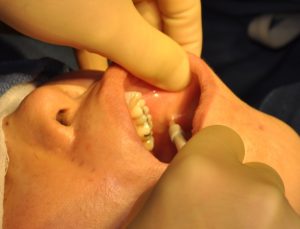Cheek dimples are natural indentations some people have when they smile. Although some people have them naturally when they are not smiling and they merely become deeper when they do. The aesthetics of cheek dimples are personal, some like them and want them placed and a few others have them wand want them reduced/removed.
The anatomic basis of cheek dimples has been shown to be a defect or diastasis in the muscle layer between the skin and the buccal mucosal lining of the mouth. This is demonstrated by how a dimple deepens when one smiles. Depending upon the location on the cheek, this could involve the zygomaticus or buccinator facial muscles. Although this does not fully explain why one can have a cheek dimple without any facial animation, indicating that there must be a fat defect as well in some patients.
The surgical creation of a cheek dimple, often called a cheek dimpleplasty, does not have a standard technique. It is still a relatively uncommon procedure done by just a few plastic surgeons. How to effectively create a cheek dimple, and then have it maintained, varies amongst different surgeons.

The authors chose to call their cheek dimple procedure a transoral buccinator-pexy, which is an anatomic description of what is actually done. This technique is remarkably similar to the cheek dimple creation technique that I have evolved to over the years. I still refrain from using a permanent suture having had a few infections and extrusions from a permanent suture. This is a risk when a permanent suture is placed into the dermis of the skin. I have found good success even using a 4-0 plain suture on a straight needle.
Regardless of these suture nuances, this technique of cheek dimpleplasty is a very safe and effective one that can be done successfully under local anesthesia.
Dr. Barry Eppley
Indianapolis, Indiana


